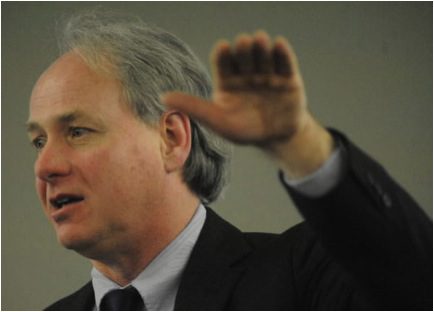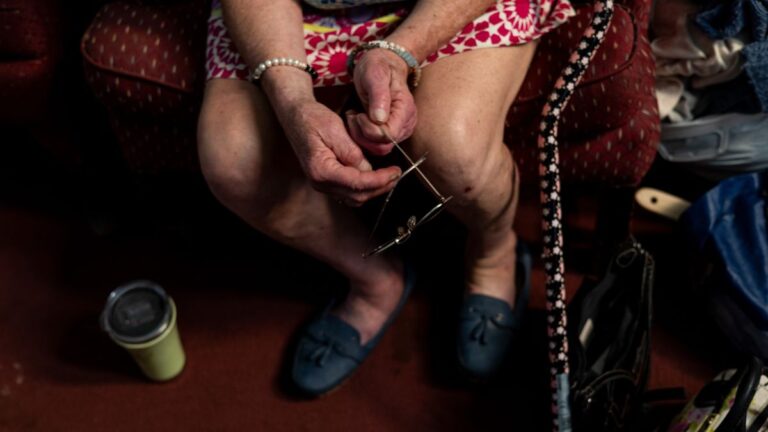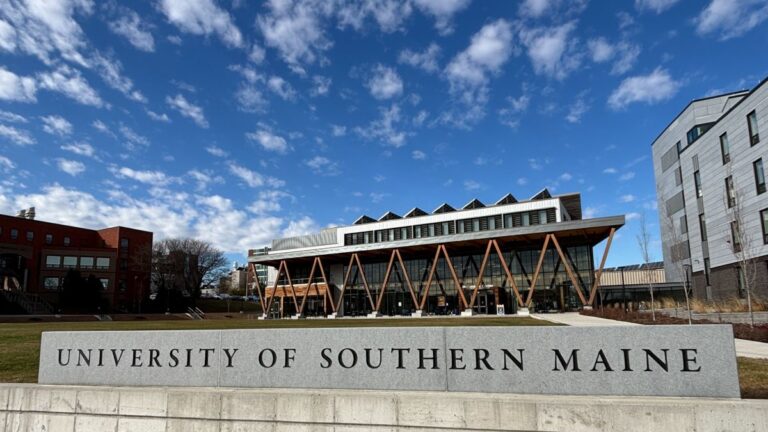Four years ago, when the University of Maine System was cutting programs to save money, officials were criticized for not, instead, making up the shortfall by taking money from System reserves.
At the time, officials said they needed all of the $88 million in the reserve account as a contingency for the unexpected and other expenses.
Now, the System says it is again under financial pressure – Gov. Paul LePage’s budget proposal for the two years starting July 1 calls for no funding increase for the university system.
The first campus to feel the pinch is the University of Southern Maine, based in Portland, which plans to cut expenses $5 million, mostly from faculty and staff reductions.
Meanwhile, reserves have doubled in those four years — to $177 million.
And over a 12-year period, the reserves are up more than 300 percent. During the same period, the cost of running the System has gone up only 41 percent.
Experts on university finance, faculty and students are saying that the System — which oversees the seven state universities — would be better served by using some of that growth in reserves to offset the cuts.
But the response from System officials is the same: All of that money – termed “unrestricted net assets” — is needed for emergencies, capital projects and unexpected expenses.
System Chancellor James Page said the term “doesn’t mean that there’s a giant bank account with $177 million in it … the overwhelming amount of that money is allocated now towards a whole host of functions and services.”
But Page also acknowledged that the government accounting standards the System follows would allow the trustees to switch part of the reserve fund to other uses.
At the end of each fiscal year, budgeted funds that are not spent accumulate in the reserve fund, which also increases (or decreases) from investment results. Most of that money came, originally, from taxpayers, through the state’s annual allocation, and from tuition and fees paid by students and their parents.
Page gave an example of where a portion of the reserve fund is allocated — about $18 million is in a “benefits carryover pool” that ensures the system could meet a run in medical claims (the System is self-insured).
“One can argue, in certain instances, ‘Are they properly allocated?’” Page said.
They’re not, said Ed Collom, a USM sociology professor and president of the union that represents faculty.
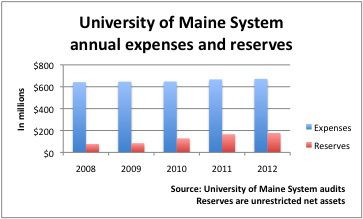
He said, “The $5 million budget cut could be easily absorbed by the System reserves … they’re essentially decimating the university,” where 22 positions will be eliminated or discontinued and 25 courses cancelled.
All of the system’s approximately 1,200 full-time faculty are working under the provisions of their previous contract, which expired on June 30, 2011. Faculty at USM, Farmington, Presque Isle and Machias have instituted “work to rule” provisions to put pressure on the System to get a new contract and a pay increase, according to public statements by Collom.
Two scholars in university finance who have reviewed the System’s financial reports agree with that view.
Rudy Fichtenbaum, a professor of economics at Wright State University in Dayton, Ohio, is the author of “Understanding College and University Financial Statements.”
Fichtenbaum, who is active in the national union that represents college professors, said the System is “in very good financial condition and could use some of those reserves to deal with any budget shortfalls.”
Has ‘rainy day’ arrived?
Howard Bunsis, a professor of accounting at Eastern Michigan University, said, “The reserves are there for a rainy day. When things aren’t going so well, instead of laying people off, you use the reserves … so you don’t hurt the mission of the university.”
Fichtenbaum said a formula used by Moody’s credit rating service measures university finances on a scale of one to five, five being the top rating.
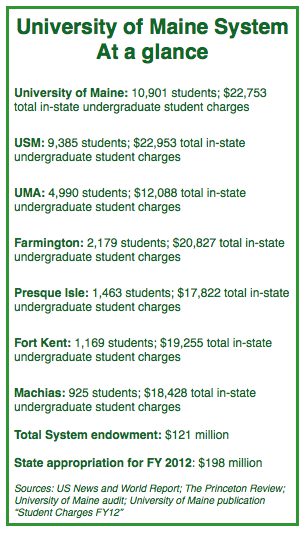
“Maine,” he said, “would be closer to five than four.”
He said there are two reserve accounts the System could dip into in the short term at least, to reduce the effects of budget cuts on academics.
One is the $177 million unrestricted fund and the other is the “expendable restricted assets” of $92 million – that’s a combined $269 million in what is called “primary reserves.”
One of the key measures of a university’s fiscal health is the ratio of the primary reserves to the annual cost of running a university or university system. In Maine, the ratio is just shy of .4, meaning that if the System were suddenly out of money, the reserves could keep the campuses running for 40 per cent of the year, based on its annual operating expenses of $680 million, including interest payments, according to both professors.
The System’s own budget document supports that number, stating that the System “has a little less than 4 1⁄2 months worth of operating expense held in reserve. The benchmark for public institutions of higher education is 5 months. This ratio also varies by campus, leaving some of our institutions extremely vulnerable when State appropriation is reduced or enrollment declines occur.”
Bunsis said that level of reserves “certainly puts them at the top of non-profit organizations … if they dipped into them to preserve their mission, they would still have plenty left” to meet unexpected expenses.
Need ‘haywire’ money
Chancellor Page counters that, except for $10 million allocated “in case something goes haywire,” the balance of the $177 million unrestricted reserves is earmarked for “ongoing and critical functions.”
Low, who was the state’s chief budget officer under Gov. John Baldacci, said that 75 percent of the reserves, although shown in the System’s balance sheet, are allocated to the campuses in various categories. “When you’re trying to run a campus and the physical plant, there have not been a lot of state bonds to address campus facilities.”
Page said while the trustees could change how the reserves are allocated, “that would require undoing some things … you would either have to stop or undo capital projects central to campus activities.”
Fichtenbaum characterized this explanation as “a ruse.”
“If circumstances have changed,” he said, “there is no legal reason why the administration or the board cannot re-designate the use of unrestricted net assets to support the core mission of the institution — teaching and research.”
Echoes of 2009
The debate over the use of the System’s reserves echoes a public disagreement from 2009 — when state support to the System was cut, salaries were frozen and tuition increased.
The reserve fund that year stood at $88 million — double what it had been in 2001.
The apparent discrepancy between a growing reserve and the System’s budget cuts prompted the student senate at the University of Southern Maine to commission a study of System finances.
Bunsis, the Michigan accounting professor hired for the study, concluded that the $88 million in reserves indicated the System was financially healthy and could use some of the reserves to offset cuts.
But students and faculty lost that fight — the cuts were made.
Molly Dolby was a USM student senate chair and one of the leaders of that fight. The Hallowell native now works for a venture capital fund in Colorado.
The doubling of the reserves in the few years since she graduated make her “absolutely” more convinced than ever that her alma mater is being unnecessarily damaged by budget cuts.
“I know a few people who are losing their jobs and knowing they are integral to the student body is incredibly alarming, beyond infuriation,” she said.
Susan Feiner has been on the USM faculty since 1995 as professor of women and gender studies and economics, and holds a doctorate in economics.
“As a professor close to the effects of budget cuts at USM and the University of Maine System,” she said, “I’m reminded of what passed for logic in Vietnam: ‘We had to destroy the village in order to save it.’ Given the many outside confirmations of the UMaine System’s financial health, there is no rational explanation for the ruthless, ill-timed, destructive gutting of the core academic mission. I guess they have to destroy the university in order to save it.”
Page disputes that view: “We take any change in academic programs very seriously,” he said, explaining that the budget reviews include “looking at savings in administration.”
“In general,” he said, “we’re going to be reallocating from both sides to make sure we have the best programs for the students and the most affordable.”
In the state legislature, one House member has proposed legislation to make the state universities more affordable and attractive to the best in-state students. But he said he’s met resistance from the System.
Rep. Ben Chipman, an independent from Portland, has proposed free tuition for any Maine high school graduate in the top 25 per cent of their class who comes from a home with annual income under $30,000.
He said the idea comes from people in his district, the Parkside and Bayside neighborhoods where there are many lower-income families and college students.
They told him how they struggle to pay Maine tuition, assuming debt, working at low-wage jobs and taking seven or eight years to get a four-year degree.
“They told me some states have this,” he said, and found more than a dozen that offer such scholarships.
The idea quickly gained bipartisan support, with 112 legislators signing on as co-sponsors, including leadership from both parties.
The cost of the program has not yet been calculated, but Chipman said he would be willing to start small “just so we can get this off the ground.”
But when he spoke to Low, the System’s lobbyist, he said Low told him the system can’t afford to pay for any more scholarships than they already do and that the state would have to come up with the money.
“It’s a great idea,” Low recalled, “but you need to identify resources to put behind it. Do you take money from the benefit pool carryover? The campuses have made investments in scholarship and paid for them.”
Now, said Chipman, “I am surprised to hear about the sum of money sitting in reserves. I found it hard to believe at the time that they couldn’t afford to get this program started, but now, with $177 million, honestly, they have the money available.”
The chancellor said he has run across many people who he thinks take the reserve account “a little too literally … it’s just sitting there waiting to find new uses and ways to be spent. Would that were to be the case.”
He also acknowledged that, “We have not done a good job getting that out in front of people.”


